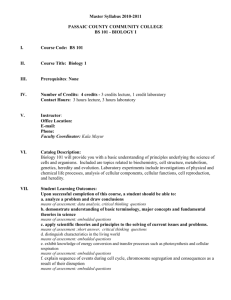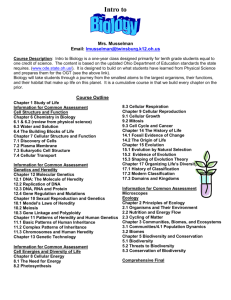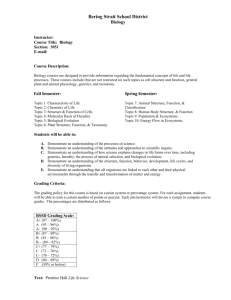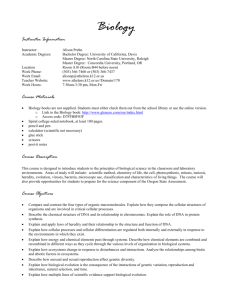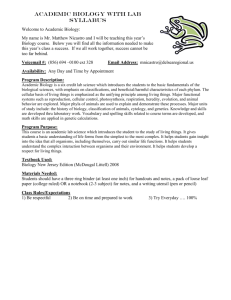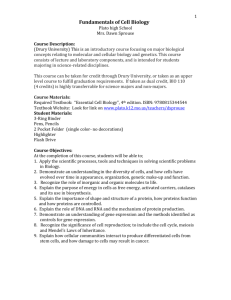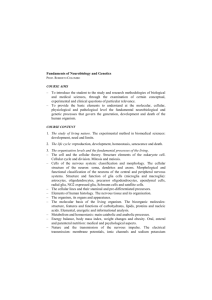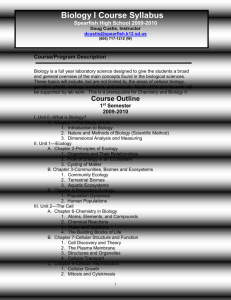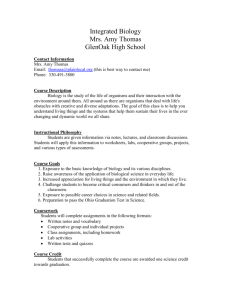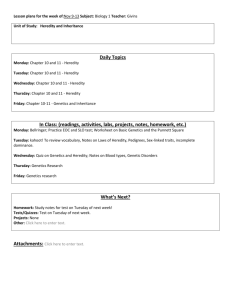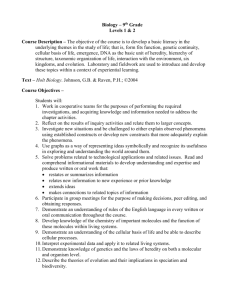Honors Physical Science
advertisement
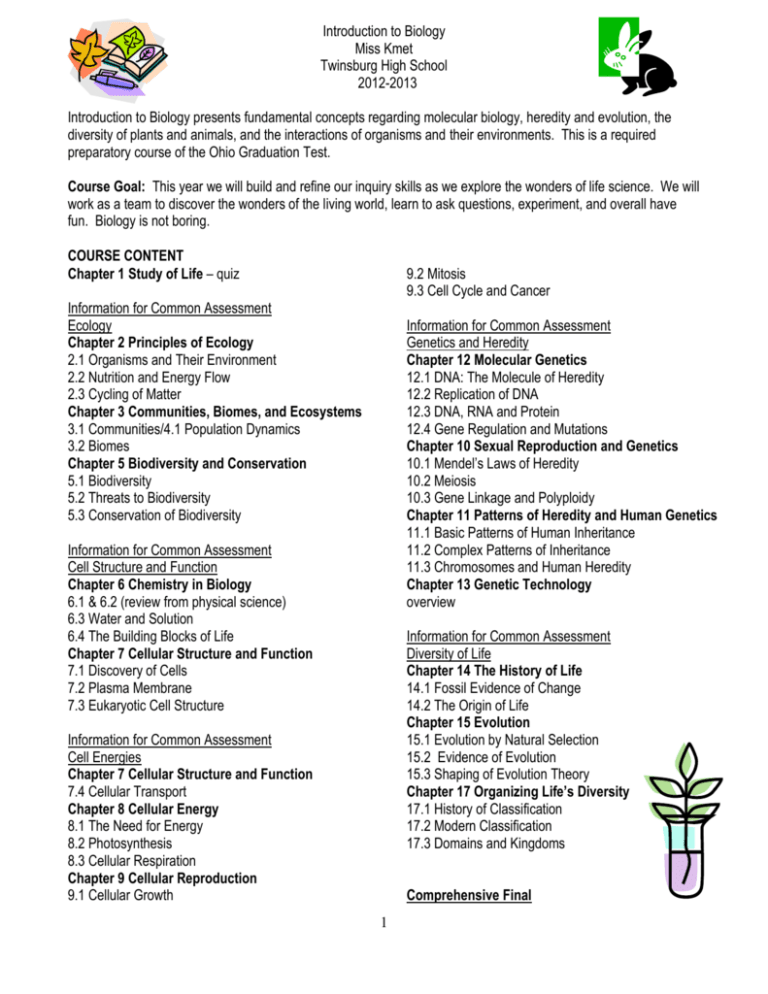
Introduction to Biology Miss Kmet Twinsburg High School 2012-2013 Introduction to Biology presents fundamental concepts regarding molecular biology, heredity and evolution, the diversity of plants and animals, and the interactions of organisms and their environments. This is a required preparatory course of the Ohio Graduation Test. Course Goal: This year we will build and refine our inquiry skills as we explore the wonders of life science. We will work as a team to discover the wonders of the living world, learn to ask questions, experiment, and overall have fun. Biology is not boring. COURSE CONTENT Chapter 1 Study of Life – quiz 9.2 Mitosis 9.3 Cell Cycle and Cancer Information for Common Assessment Ecology Chapter 2 Principles of Ecology 2.1 Organisms and Their Environment 2.2 Nutrition and Energy Flow 2.3 Cycling of Matter Chapter 3 Communities, Biomes, and Ecosystems 3.1 Communities/4.1 Population Dynamics 3.2 Biomes Chapter 5 Biodiversity and Conservation 5.1 Biodiversity 5.2 Threats to Biodiversity 5.3 Conservation of Biodiversity Information for Common Assessment Genetics and Heredity Chapter 12 Molecular Genetics 12.1 DNA: The Molecule of Heredity 12.2 Replication of DNA 12.3 DNA, RNA and Protein 12.4 Gene Regulation and Mutations Chapter 10 Sexual Reproduction and Genetics 10.1 Mendel’s Laws of Heredity 10.2 Meiosis 10.3 Gene Linkage and Polyploidy Chapter 11 Patterns of Heredity and Human Genetics 11.1 Basic Patterns of Human Inheritance 11.2 Complex Patterns of Inheritance 11.3 Chromosomes and Human Heredity Chapter 13 Genetic Technology overview Information for Common Assessment Cell Structure and Function Chapter 6 Chemistry in Biology 6.1 & 6.2 (review from physical science) 6.3 Water and Solution 6.4 The Building Blocks of Life Chapter 7 Cellular Structure and Function 7.1 Discovery of Cells 7.2 Plasma Membrane 7.3 Eukaryotic Cell Structure Information for Common Assessment Diversity of Life Chapter 14 The History of Life 14.1 Fossil Evidence of Change 14.2 The Origin of Life Chapter 15 Evolution 15.1 Evolution by Natural Selection 15.2 Evidence of Evolution 15.3 Shaping of Evolution Theory Chapter 17 Organizing Life’s Diversity 17.1 History of Classification 17.2 Modern Classification 17.3 Domains and Kingdoms Information for Common Assessment Cell Energies Chapter 7 Cellular Structure and Function 7.4 Cellular Transport Chapter 8 Cellular Energy 8.1 The Need for Energy 8.2 Photosynthesis 8.3 Cellular Respiration Chapter 9 Cellular Reproduction 9.1 Cellular Growth Comprehensive Final 1 COURSE REQUIREMENTS o A neat, organized binder containing only science materials. An organized binder reflects an organized mind. Binder dividers would be helpful, but are not required. It is strongly suggested that you keep an organized binder of biology work only, especially if you are planning on taking AP Biology at any point. o Loose-leaf notebook paper (no fringe please!!) o A pen (blue or black ink only) or pencil. o Colored pencils o One pack 3X5 index cards o A glue stick or scotch tape CLASSROOM RULES AND PROCEDURES o Come to class prepared and on time. o Please no eating or drinking in class. This is a science classroom and is not a suitable environment to eat in. You will be asked to throw away or put away any food or drink. o Sinks, counters, and my desk area are off limits unless otherwise instructed. o Please choose an appropriate time to sharpen your pencil, get a tissue, use the hole puncher, etc. o Leave the classroom as it looked when you arrived. Do not leave a mess behind. o Assignments are due at the beginning of your block, not after lunch or after school. COURSE EVALUATION AND GRADING Grades are based upon points accumulated by the student throughout the grading period. Tests will comprise 50% of the course grade. Tests (also called common assessments) will be given at the completion of each unit (see above.) A quiz is usually given at the conclusion of each chapter, approximately once a week. Labs will be as frequent as course content allows. Course evaluation will be broken down as follows: Unit Tests – 50% Quizzes – 20% Labs – 20% Classwork and Homework – 10% Homework is given with the goal being the introduction or reinforcement of a topic. However, weekly quizzes will be given, so it is important that the student does the homework in order to do well on the quizzes. It is the instructor’s discretion as to which assignments will be collected and graded for points. Quarter grades WILL NOT be rounded up. If your grade is borderline, I may add one additional point to the unit test category. This is the maximum that I will do. Otherwise, your grade is what it is. SUBMISSION OF STUDENT WORK Each student will be assigned a number that must accompany every assignment that is turned in. This greatly assists in the efficiency in which your grade is entered. Failure to record your name and number on a submitted assignment will result in a small grade penalty. All submitted work will be turned in at the front of the room in the appropriate class file. I am NOT responsible for work not submitted in the appropriate file. RETURN FROM ABSENCE Students should check with the instructor for missing work. In the event that you are home sick, it is helpful to email the instructor. This way, classwork can be easily forwarded on. Extra printed copies will not be available, aside from the copies made initially. Retrieval of absent work will be done on the student’s time (i.e. lunch, at home) and not during class. In addition, students will have to copy the notes that were missed from a classmate. The student is responsible for ALL work and material covered that was missed in their absence. It is the student’s 2 responsibility to arrange a time to make up labs, quizzes, and tests. This can be before or after school or possibly during study lab. Work that is not made up will turn into a zero. Unexcused absences earn an automatic zero. HALL PASSES Hall passes will be given on a limited basis. Students who prove to abuse the hall pass system will be denied any additional hall passes. Students must have a pass when entering class late. CONSEQUENCES All students will know the expectations of the class and routine procedures by the end of the first week of school. Students will need to pass the lab equipment and safety practical with an 85% accuracy before participating in labs. Students who fail to follow the guidelines that govern our class and harm the safety of themselves or others will be subjected to the following consequences: 1st offense – Warning and student teacher conference 2nd offense – After school detention and student conference 3rd offense – Detention and student conference with parent/guardian contact 4th offense - Office referral, and parent contact 5th offense – Removal from class and office referral **The teacher reserves the right to skip steps due to the severity of the situation. SAFETY The science classroom can be a very safe and productive environment when the students and teacher follow proper safety guidelines. Students who do not follow the safety guidelines including proper clothing, protective equipment, and lab practices risk harming themselves and others in the classroom. Students who fail to follow safety guidelines will be removed from the activity and given an alternative assignment. All students must have a signed safety contract on file before being allowed to participate in labs. Students are expected to treat all lab equipment and other students with respect. Do not harass other students or touch their belongings. Students will be responsible for cleaning up after themselves. Summary of Expectations 1. Listen when others are talking. 2. Follow directions. 3. Keep hands, feet, and objects to yourself. 4. Work quietly and do not disturb others. 5. Show respect for school and personal property. 6. Work in a safe manner. 3
